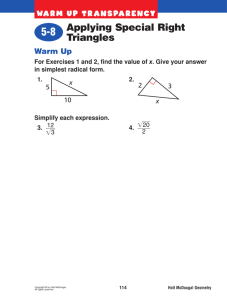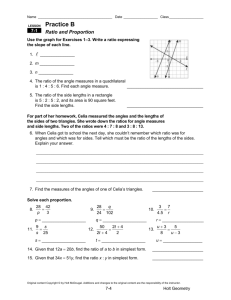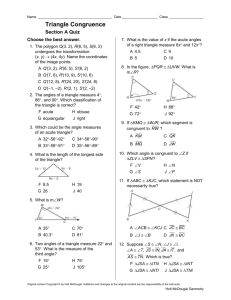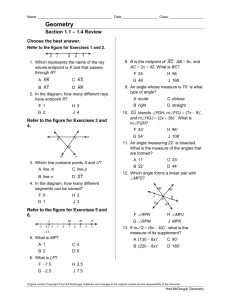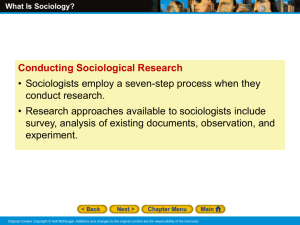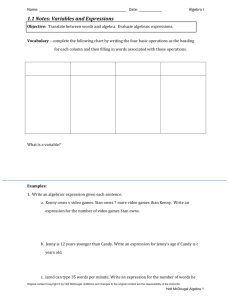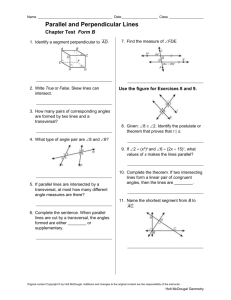Social Cognition
advertisement
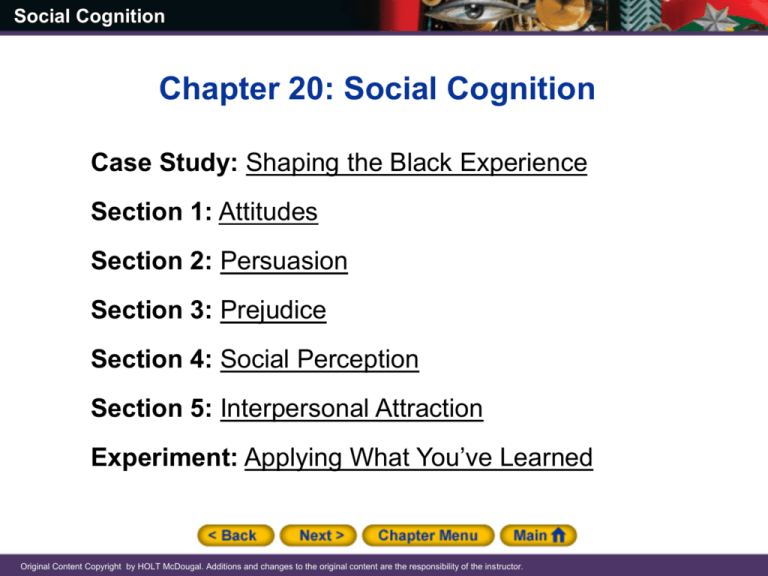
Social Cognition Chapter 20: Social Cognition Case Study: Shaping the Black Experience Section 1: Attitudes Section 2: Persuasion Section 3: Prejudice Section 4: Social Perception Section 5: Interpersonal Attraction Experiment: Applying What You’ve Learned Original Content Copyright by HOLT McDougal. Additions and changes to the original content are the responsibility of the instructor. Social Cognition Case Study: Shaping the Black Experience W.E.B. Du Bois was an influential African American educator and writer who was born just five years after the Emancipation Proclamation. In 1903 Du Bois published a classic work titled The Souls of Black Folk. The book describes the experiences of Du Bois and others as they grew up in the segregated American society. Nearly 100 years later, Neil de Grasse Tyson wrote of his experiences as a leading expert in his field, and how that experience was shaped by being an African American. Both writers challenged stereotypes and proved that black scholars have much to contribute to American society. Original Content Copyright by HOLT McDougal. Additions and changes to the original content are the responsibility of the instructor. Social Cognition Original Content Copyright by HOLT McDougal. Additions and changes to the original content are the responsibility of the instructor. Social Cognition What do you think? • What do you think Du Bois meant when he said he was "shut out from their world by a vast veil"? • Do you feel there is still prejudice, like the attitude de Grasse Tyson faced, about people's intellectual abilities? Original Content Copyright by HOLT McDougal. Additions and changes to the original content are the responsibility of the instructor. Social Cognition Section 1 at a Glance Attitudes • Attitudes are beliefs and feelings that can affect how people behave in certain situations. • Attitudes develop in a number of ways throughout people’s lives. Sometimes behaviors follow attitudes, and sometimes attitudes follow behaviors. Original Content Copyright by HOLT McDougal. Additions and changes to the original content are the responsibility of the instructor. Social Cognition Attitudes Main Idea Attitudes are an important aspect of our psychological lives because they are a major motivator for how we behave and view the world. Reading Focus • What are some basic concepts in understanding attitudes? • How do attitudes develop? • How are attitudes and behaviors related? Original Content Copyright by HOLT McDougal. Additions and changes to the original content are the responsibility of the instructor. Social Cognition Why might you ignore your own beliefs? Original Content Copyright by HOLT McDougal. Additions and changes to the original content are the responsibility of the instructor. Social Cognition Understanding Attitudes • Attitudes: beliefs and feelings about objects, people, and events that can affect how people behave in certain situations • A major aspect of social cognition • May be the primary motivator for how we behave and how we view the world • Important because they foster strong emotions • Social psychology: studies human interactions Original Content Copyright by HOLT McDougal. Additions and changes to the original content are the responsibility of the instructor. Social Cognition Reading Check Define What are attitudes? Answer: beliefs and feelings about objects, people, and events that can affect how people behave in certain situations Original Content Copyright by HOLT McDougal. Additions and changes to the original content are the responsibility of the instructor. Social Cognition How Attitudes Develop Conditioning Observational Learning • Learning by reinforcement • Teens may observe that classmates who dress, talk, or act in certain ways seem to be admired by their peers. • Parents who believe that it is important to share may praise, or reinforce, a child who shares a toy with a friend. • Child acquires an attitude about the importance of sharing. • Teen acquires attitude about these behaviors and may mimic them. • Commercial advertising often relies on observational learning in order to sell products. Original Content Copyright by HOLT McDougal. Additions and changes to the original content are the responsibility of the instructor. Social Cognition How Attitudes Develop Cognitive Evaluation Cognitive Anchors • Cognitive evaluation: evaluating evidence and forming beliefs on the basis of these evaluations. • Cognitive anchors: persistent beliefs that shape the ways in which a person sees the world and interprets events. Often they are the person’s earliest attitudes. • Part of the process is to examine data carefully. - Bias - What is gained • People are especially likely to evaluate evidence when they will have to justify their choice. • People who hold on to cognitive anchors for decades rarely adopt significantly new attitudes. Original Content Copyright by HOLT McDougal. Additions and changes to the original content are the responsibility of the instructor. Social Cognition Original Content Copyright by HOLT McDougal. Additions and changes to the original content are the responsibility of the instructor. Social Cognition Reading Check Identify Main Ideas What are two of the four ways that people’s attitudes develop? Answer: two of the following: conditioning, observational learning, cognitive evaluation, use of cognitive anchors Original Content Copyright by HOLT McDougal. Additions and changes to the original content are the responsibility of the instructor. Social Cognition Attitudes and Behavior Definition of attitudes suggests that people’s behaviors are always consistent with their attitudes. However, people often behave in ways that contradict their attitudes. When Behavior Follows Attitudes When Attitudes Follow Behavior • Behavior in accordance with attitudes is more common if a behavior is tied to an attitude. • Attitudes are likely to follow behavior when people begin to behave in ways that conflict with their attitudes. • Strong attitudes are better predictors of behavior than weak. • More likely when people are aware of their attitudes. • Dissonance arises from conflict between attitudes and behavior. Original Content Copyright by HOLT McDougal. Additions and changes to the original content are the responsibility of the instructor. Social Cognition Reading Check Recall How do attitudes and behavior shape one another? Answer: Attitudes often guide behaviors, but behaviors can contradict attitudes. Original Content Copyright by HOLT McDougal. Additions and changes to the original content are the responsibility of the instructor. Social Cognition Current Research in Psychology Attitudes and Achievement How do you feel about school? According to a recent study, your attitude and behavior can have a direct impact on your academic achievement. • Researchers looked at students’ engagement in school, or their level of participation and interest, and at students’ own view of their academic success. • These two traits are closely linked. • Study demonstrated that those who were more engaged and had a more positive view of their abilities achieved greater academic success. • Activities that encourage interaction result in more engaged students. • High expectations and clearly defined rules also help student achievement. Original Content Copyright by HOLT McDougal. Additions and changes to the original content are the responsibility of the instructor. Social Cognition Original Content Copyright by HOLT McDougal. Additions and changes to the original content are the responsibility of the instructor. Social Cognition Thinking Critically • How can schools instill in students an attitude of belief in their academic abilities? • Which of the two factors examined in the study do you think is more important to academic achievement? Why? Original Content Copyright by HOLT McDougal. Additions and changes to the original content are the responsibility of the instructor. Social Cognition Section 2 at a Glance Persuasion • Persuasion is the direct attempt to influence others’ attitudes. • People can be persuaded via the central route, using evidence and logic, or via the peripheral route, using positive and negative associations and cues. Original Content Copyright by HOLT McDougal. Additions and changes to the original content are the responsibility of the instructor. Social Cognition Persuasion Main Idea People use a range of persuasive techniques to try to change other people’s attitudes. These techniques can be direct, relying on logic or evidence, or indirect, relying on emotions or perception. Reading Focus • What are the main methods of persuasion? • How do the message and the messenger relate to persuasion? • How do the situation and the audience affect persuasion? • How can one resist persuasive messages? Original Content Copyright by HOLT McDougal. Additions and changes to the original content are the responsibility of the instructor. Social Cognition What face do you want the world to see? Original Content Copyright by HOLT McDougal. Additions and changes to the original content are the responsibility of the instructor. Social Cognition Methods of Persuasion • Persuasion: a direct attempt to influence other people’s attitudes or views. • Two basic ways to persuade people: – Central route: use evidence and logical arguments to persuade people – Peripheral route: attempts to associate objects, people, or events with positive or negative cues • The most persuasive messages use both routes. Original Content Copyright by HOLT McDougal. Additions and changes to the original content are the responsibility of the instructor. Social Cognition Reading Check Recall What are the two central routes of persuasion? Answer: using evidence and logical arguments to persuade people Original Content Copyright by HOLT McDougal. Additions and changes to the original content are the responsibility of the instructor. Social Cognition Original Content Copyright by HOLT McDougal. Additions and changes to the original content are the responsibility of the instructor. Social Cognition Message and Messenger In the central route, the message itself is most important. In the peripheral route, the message is important, but it does not stand alone. The messenger also plays an important role. Repetition Two-Sided Arguments • Repeated exposure to a stimulus eventually results in a more favorable attitude toward that stimulus. • Two-sided arguments: the messenger presents not only his or her side of the argument but also the opposition’s side to discredit the opposition’s view. • Advertisers and others use repetition to create positive reactions to their products. • Admitting weakness can make an argument more believable. Original Content Copyright by HOLT McDougal. Additions and changes to the original content are the responsibility of the instructor. Social Cognition Emotional Appeals • Emotional appeals: arouse such feelings as loyalty, admiration, desire, jealousy, or fear rather than by convincing through evidence and logic. • A peripheral route Glittering Generalities • Use of vaguely positive words and images without citing specific evidence or promises Role of the Messenger • Some people are more persuasive: those who are experts, trustworthy, physically attractive, or similar to their audience in ethnicity, age, and other physical characteristics. • Messengers who stand to gain from the effort are less believable. Original Content Copyright by HOLT McDougal. Additions and changes to the original content are the responsibility of the instructor. Social Cognition Original Content Copyright by HOLT McDougal. Additions and changes to the original content are the responsibility of the instructor. Social Cognition Reading Check Describe In what kind of persuasion is the messenger important? Answer: peripheral route messages Original Content Copyright by HOLT McDougal. Additions and changes to the original content are the responsibility of the instructor. Social Cognition Situation and Audience • When a person is in a good mood, he or she is less likely to evaluate messages carefully. • Most messages are aimed at a specific audience. • Differences in audience can affect the best way to deliver a message to be the most persuasive. Original Content Copyright by HOLT McDougal. Additions and changes to the original content are the responsibility of the instructor. Social Cognition Reading Check Describe How might the use of the situation and the audience easily be combined to aid in persuasion? Answer: messages tailored to audience more persuasive Original Content Copyright by HOLT McDougal. Additions and changes to the original content are the responsibility of the instructor. Social Cognition Resisting Persuasive Messages • Sales resistance: having no trouble turning down requests to buy products or services. • People without sales resistance find it difficult to refuse a sales pitch or other types of requests. • Two factors may affect sales resistance: self-esteem and social anxiety. Original Content Copyright by HOLT McDougal. Additions and changes to the original content are the responsibility of the instructor. Social Cognition Reading Check Identify Main Ideas How is self-esteem related to sales resistance? Answer: People with low self-esteem find it difficult to say no. Original Content Copyright by HOLT McDougal. Additions and changes to the original content are the responsibility of the instructor. Social Cognition Section 3 at a Glance Prejudice • A prejudice is a generalized attitude toward a specific group of people. Prejudiced attitudes are based on stereotypes, which can then lead to discrimination. • People can overcome prejudice by learning about others and by speaking up when others communicate or behave in prejudicial ways. Original Content Copyright by HOLT McDougal. Additions and changes to the original content are the responsibility of the instructor. Social Cognition Prejudice Main Idea Prejudice occurs when people prejudge and stereotype other groups, and it can result in discrimination. Prejudice has deep-seated social and psychological causes that can be overcome. Reading Focus • What attitudes and actions are part of the prejudicial view? • What are some of the causes of prejudice? • What are some ways that individuals can help overcome prejudice? Original Content Copyright by HOLT McDougal. Additions and changes to the original content are the responsibility of the instructor. Social Cognition Is there anything wrong with this picture? Original Content Copyright by HOLT McDougal. Additions and changes to the original content are the responsibility of the instructor. Social Cognition The Prejudicial View Prejudice: a generalized attitude toward a specific group of people. People who are prejudiced judge other people on the basis of their group membership rather than as individuals. Prejudices are based on stereotypes. Stereotypes • Unchanging, oversimplified, and usually distorted beliefs about groups of people. • People tend to develop stereotypes as a way to organize information about their social world. • People also assume that those who are different from themselves are similar to each other in many ways. • Stereotypes are harmful because they ignore people’s individual natures and assign traits by group membership. Original Content Copyright by HOLT McDougal. Additions and changes to the original content are the responsibility of the instructor. Social Cognition Click on the image to play the Interactive. Original Content Copyright by HOLT McDougal. Additions and changes to the original content are the responsibility of the instructor. Social Cognition • Stereotypes can also include positive traits. • Stereotype threat occurs when members of a group are aware of a stereotype that says they cannot perform a certain task, and perform worse at the task because of this assumption. • Stereotype threat occurs when members of a group are aware of a stereotype that says they cannot perform a certain task, and perform worse at the task because of this assumption. Discrimination • Discrimination: the unfair treatment of individuals because they are members of a particular group. • Skin color, sex, religion, and even weight can be the basis of discrimination. • Victims of every type of discrimination often begin to see themselves as inferior and to have low self-esteem. • Even positive stereotypes can be harmful. Original Content Copyright by HOLT McDougal. Additions and changes to the original content are the responsibility of the instructor. Social Cognition Reading Check Compare What is the connection between stereotyping and discrimination? Answer: Discrimination is often based on stereotyping, which ignores people’s individual natures and assigns them traits on the basis of groups to which they belong. Original Content Copyright by HOLT McDougal. Additions and changes to the original content are the responsibility of the instructor. Social Cognition Causes of Prejudice Exaggerating Differences • Some are prejudiced because they exaggerate how different others are from themselves. Justifying Economic Status • Some are prejudiced against those in a different economic group. • People tend to prefer those who are similar to themselves. • Such beliefs may be used as an excuse for injustices. Social Learning Victimization • Children acquire the attitudes from parents. • Sometimes people who are the victims of prejudice feel empathy for others who are discriminated against, but some may come to discriminate against a third group in order to feel superiority. • Prejudices are passed from parents to children. Original Content Copyright by HOLT McDougal. Additions and changes to the original content are the responsibility of the instructor. Social Cognition Scapegoating • A scapegoat is an individual or group that is blamed for the problems of others because the real cause of the problems is either too complex, too powerful, or too remote to be confronted. • The term scapegoating refers to aggression against the targeted group. • A scapegoat group has characteristics that make it highly visible and safe to attack. • The most famous example is the Holocaust, in which millions of Jews were killed. Original Content Copyright by HOLT McDougal. Additions and changes to the original content are the responsibility of the instructor. Social Cognition Original Content Copyright by HOLT McDougal. Additions and changes to the original content are the responsibility of the instructor. Social Cognition Reading Check Identify Name and describe three potential causes of prejudice. Answer: Students should choose three of the following: exaggerating differences, justifying economic status, social learning, victimization, scapegoating. Original Content Copyright by HOLT McDougal. Additions and changes to the original content are the responsibility of the instructor. Social Cognition Overcoming Prejudice • Although difficult to overcome, it is possible. • Increased contact among members of different groups • Speaking up when other people act or talk in ways that reveal prejudicial attitudes • Set an example with own words and actions Original Content Copyright by HOLT McDougal. Additions and changes to the original content are the responsibility of the instructor. Social Cognition Reading Check Recall How can increased contact between groups help to lessen prejudice? Answer: People learn about each other as individuals. Original Content Copyright by HOLT McDougal. Additions and changes to the original content are the responsibility of the instructor. Social Cognition Psychology in Today’s World Seeds of Peace The organization Seeds of Peace believes the best way for people from around the world to change their attitudes about each other is to meet face to face. • Seeds of Peace began in 1994 as a way to bring youth from Israel, Egypt, and Palestine together to live and learn together. • Main focus is to develop leadership skill required to advance reconciliation and coexistence in their troubled homelands. • Although the camp began with children from the Middle East, it eventually included teens from other major conflict regions, such as South Asia and the Balkans. • Facing and interacting with the very people they are supposed to hate provides the teens with opportunities to view each other as individuals. Original Content Copyright by HOLT McDougal. Additions and changes to the original content are the responsibility of the instructor. Social Cognition Original Content Copyright by HOLT McDougal. Additions and changes to the original content are the responsibility of the instructor. Social Cognition Thinking Critically • How do participants learn about one another as individuals? • Why do you think the Seeds of Peace summer camp helps participants dispel prejudicial attitudes? Original Content Copyright by HOLT McDougal. Additions and changes to the original content are the responsibility of the instructor. Social Cognition Section 4 at a Glance Social Perception • People form attitudes about one another based on their social perceptions. First impressions play a large role in this process. • In general, people tend to judge the behaviors of others more harshly than they do their own behavior. They also tend to attribute different motives to others than they do to themselves. • The multiple forms of nonverbal communication have important parts in social perception. Original Content Copyright by HOLT McDougal. Additions and changes to the original content are the responsibility of the instructor. Social Cognition Social Perception Main Idea Social perception refers to how we see and what we feel about others. Social perception is heavily influenced by first impressions, differing vantage points, and nonverbal cues. Reading Focus • To what extent do people form perceptions based on first impressions? • What does attribution theory say about how we perceive ourselves and others? • How does nonverbal communication influence our perceptions of others? Original Content Copyright by HOLT McDougal. Additions and changes to the original content are the responsibility of the instructor. Social Cognition Can your face give you away? Original Content Copyright by HOLT McDougal. Additions and changes to the original content are the responsibility of the instructor. Social Cognition Forming Perceptions • Social perception: the ways in which people perceive one another. It affects the attitudes people form toward one another. • People think that their first impressions of other people are accurate, and are often based on how a person looks. • Primacy effect: the tendency for people to form opinions of others on the basis of first impressions. • How people interpret later behavior of others is influenced by their first impressions. • Recency effect: people change their opinions of others on the basis of recent interactions instead of holding on to their first impressions. Original Content Copyright by HOLT McDougal. Additions and changes to the original content are the responsibility of the instructor. Social Cognition Reading Check Contrast How are the primacy and recency effects different? Answer: The primacy effect describes opinions based on first impressions; the recency effect describes opinions that change based on recent interactions. Original Content Copyright by HOLT McDougal. Additions and changes to the original content are the responsibility of the instructor. Social Cognition Attribution Theory • Attribution theory: tendency to explain behavior in terms of either dispositional, or personality, factors or in terms of situational, or external, factors Fundamental Attribution Error • Fundamental attribution error: the overestimation of the effect of dispositional causes for another person’s behavior and underestimation of situational causes Actor-Observer Bias Self-Serving Bias • Actor-observer bias: tendency to attribute the behavior of others to internal factors and the behavior of self to external factors • Self-serving bias: tendency to attribute own successes to dispositional factors and own failures to situational factors Original Content Copyright by HOLT McDougal. Additions and changes to the original content are the responsibility of the instructor. Social Cognition Reading Check Explain What are dispositional factors and situational factors? Answer: Dispositional factors are personality or internal factors that affect behavior; situational factors are external factors. Original Content Copyright by HOLT McDougal. Additions and changes to the original content are the responsibility of the instructor. Social Cognition Original Content Copyright by HOLT McDougal. Additions and changes to the original content are the responsibility of the instructor. Social Cognition Nonverbal Communication • Forms of nonverbal, or unspoken, communication include facial expressions, gestures, posture, and the distance we keep from others. • “Body language” affects our perceptions of people, largely because it often indicates feelings. • Some nonverbal forms of communication are learned very early. Physical Contact • Touching is one way to communicate nonverbally. • Studies have found that touch can affect willingness to help, the amount given in a tip, or favorable interactions. Original Content Copyright by HOLT McDougal. Additions and changes to the original content are the responsibility of the instructor. Social Cognition Eye Contact • People can learn a great deal about the feelings of others from eye contact. • When a speaker is looking into the eyes of a listener, the speaker is usually telling the truth. • Gazing can greatly influence relationships. • Staring is usually interpreted as a sign of anger. Cultural Considerations • There is considerable cultural variation in the use of nonverbal communication. – Distance people keep from each other differs around the world. • Becoming more aware of nonverbal communication can increase our understanding of others. Original Content Copyright by HOLT McDougal. Additions and changes to the original content are the responsibility of the instructor. Social Cognition Reading Check Identify What are three kinds of nonverbal communication that affect how people perceive one another? Answer: Answers should include three of the following: facial expressions, gestures, posture, physical distance, eye contact. Original Content Copyright by HOLT McDougal. Additions and changes to the original content are the responsibility of the instructor. Social Cognition Section 5 at a Glance Interpersonal Attraction • Attraction is the process by which people are drawn to others who appeal to them in a number of ways. • People are attracted by physical appearance and by similarity in personal background and attitudes. • Attraction often leads to friendship or to romantic relationships. Original Content Copyright by HOLT McDougal. Additions and changes to the original content are the responsibility of the instructor. Social Cognition Interpersonal Attraction Main Idea People are attracted to others for many reasons. Personal appearance and personality traits play significant roles, as do similarity and reciprocity. Reading Focus • How do concepts of physical appearance vary? • Why are similarity and reciprocity essential to attraction? • What is the difference between friendship and love? Original Content Copyright by HOLT McDougal. Additions and changes to the original content are the responsibility of the instructor. Social Cognition Is beauty really in the eye of the beholder? Original Content Copyright by HOLT McDougal. Additions and changes to the original content are the responsibility of the instructor. Social Cognition Physical Appearance Attraction: the process by which people are drawn to others who appeal to them in a number of ways. Factors of attraction include physical appearance, similarity to ourselves, and evidence that our attraction is returned. Universals of Beauty • Smiling is perceived as more attractive. • Large eyes, high cheekbones, and narrow jaws are more attractive in Britain and Japan. • Some evidence exists that we do not “learn” what is attractive. Differences in Body Shape Preference • Great deal of variation in people’s standard for attractive body shape. • Initial attraction one feels for another person may be based on the person’s physical appearance, but other traits become important with time. Original Content Copyright by HOLT McDougal. Additions and changes to the original content are the responsibility of the instructor. Social Cognition Reading Check Describe What part of attraction is more universal, and what parts are more particular to individual preferences? Answer: Preferences for certain facial expressions and features are more universal, while preferences for body shape vary widely. Original Content Copyright by HOLT McDougal. Additions and changes to the original content are the responsibility of the instructor. Social Cognition Similarity and Reciprocity • We are usually more attracted to people who are similar to us. Similarity in Other Characteristics • Friends and partners tend to be similar in race, ethnicity, age, level of education, and religion. Similarity in Physical Attractiveness • Matching hypothesis: people tend to choose as friends and partners those who are similar to themselves in attractiveness Reciprocity • Reciprocity: the mutual exchange of feelings or attitudes • Applies to situations in which the person we like likes us back • Often have similar attitudes. Original Content Copyright by HOLT McDougal. Additions and changes to the original content are the responsibility of the instructor. Social Cognition Original Content Copyright by HOLT McDougal. Additions and changes to the original content are the responsibility of the instructor. Social Cognition Reading Check Describe Why is similarity important in developing relationships? Answer: Most people develop relationships with people who are similar to themselves in background and attitudes; those are the people with whom they have most frequent contact. Original Content Copyright by HOLT McDougal. Additions and changes to the original content are the responsibility of the instructor. Social Cognition Friendship and Love • Friends are people for whom one has affection, respect, and trust. • The people we choose as friends tend to be people with whom we have frequent contact, such as a fellow student. • Love can refer to the feelings of attachment between children and parents, siblings, and other family members, as well as feelings of patriotism for one’s country or strongly held values. • Most commonly, however, love refers to the feelings of mutual attraction, affection, and attachment shared by people who are “in love.” • Triangular model of love: Sternbert identified seven types of love, each characterized by at least one of three components: intimacy, passion, or commitment. Original Content Copyright by HOLT McDougal. Additions and changes to the original content are the responsibility of the instructor. Social Cognition Intimacy: closeness and caring • Reflected by mutual concern, the sharing of feelings and resources Passion: feelings of romantic and sexual attraction • Reflected by verbal expressions of love, gazing, hugging, and kissing Commitment: a couple’s recognition that they are “in love” and want to be together, “for better or for worse.” Original Content Copyright by HOLT McDougal. Additions and changes to the original content are the responsibility of the instructor. Social Cognition Reading Check Analyze What are two ways in which friendship and love are related? Answer: Answers should include two of the following: mutual attraction, affection, and attachment. Original Content Copyright by HOLT McDougal. Additions and changes to the original content are the responsibility of the instructor. Social Cognition Experiment: Applying What You’ve Learned Types of Persuasion Can you correctly predict whether central or peripheral route persuasion is more effective? 1. Introduction 2. Creating the Ads • In this experiment, you will try to determine if the central or peripheral route is more effective. You may learn valuable lessons that you can use in your daily life. • Review the chapter material. • In groups, create two full-page ads for a certain product, one using the central route and one using the peripheral route. Original Content Copyright by HOLT McDougal. Additions and changes to the original content are the responsibility of the instructor. Social Cognition Original Content Copyright by HOLT McDougal. Additions and changes to the original content are the responsibility of the instructor. Social Cognition Experiment (cont'd.) 3. Forming and Testing Your Hypothesis 4. Analyzing Data and Evaluating Results • Which method will be more successful? • As a class, discuss the exercise and these questions: • Develop a questionnaire that challenges the test participants to think about how the ad affects them. • Which persuasive method was most effective? • What about the ad is appealing? • How do you feel about the product? • Does the ad speak to you? • How did the choice of product relate to each method’s effectiveness? • If you were to do this experiment again, how would you change the method to improve it? Original Content Copyright by HOLT McDougal. Additions and changes to the original content are the responsibility of the instructor.

